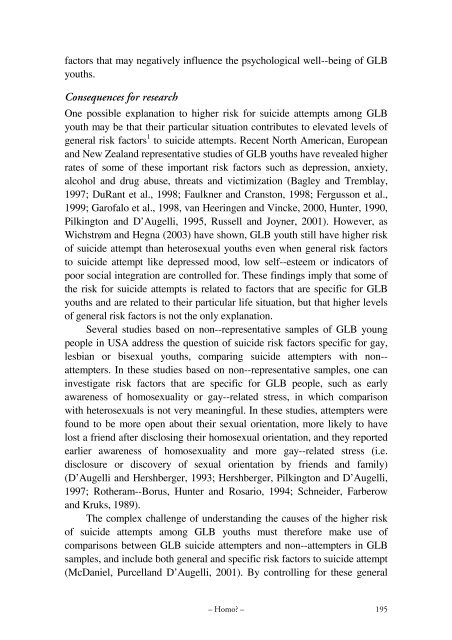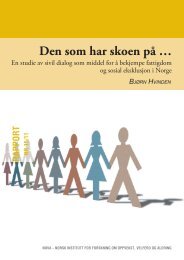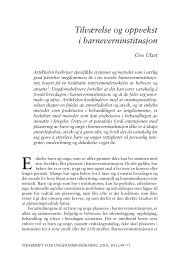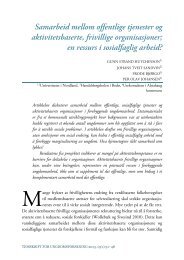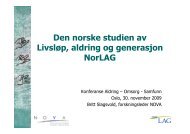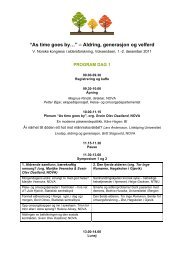Betydningen av seksuell erfaring, tiltrekning og identitet for ...
Betydningen av seksuell erfaring, tiltrekning og identitet for ...
Betydningen av seksuell erfaring, tiltrekning og identitet for ...
Create successful ePaper yourself
Turn your PDF publications into a flip-book with our unique Google optimized e-Paper software.
factors that may negatively influence the psychol<strong>og</strong>ical well--being of GLB<br />
youths.<br />
Consequences <strong>for</strong> research<br />
One possible explanation to higher risk <strong>for</strong> suicide attempts among GLB<br />
youth may be that their particular situation contributes to elevated levels of<br />
general risk factors 1 to suicide attempts. Recent North American, European<br />
and New Zealand representative studies of GLB youths h<strong>av</strong>e revealed higher<br />
rates of some of these important risk factors such as depression, anxiety,<br />
alcohol and drug abuse, threats and victimization (Bagley and Tremblay,<br />
1997; DuRant et al., 1998; Faulkner and Cranston, 1998; Fergusson et al.,<br />
1999; Garofalo et al., 1998, van Heeringen and Vincke, 2000, Hunter, 1990,<br />
Pilkington and D’Augelli, 1995, Russell and Joyner, 2001). However, as<br />
Wichstrøm and Hegna (2003) h<strong>av</strong>e shown, GLB youth still h<strong>av</strong>e higher risk<br />
of suicide attempt than heterosexual youths even when general risk factors<br />
to suicide attempt like depressed mood, low self--esteem or indicators of<br />
poor social integration are controlled <strong>for</strong>. These findings imply that some of<br />
the risk <strong>for</strong> suicide attempts is related to factors that are specific <strong>for</strong> GLB<br />
youths and are related to their particular life situation, but that higher levels<br />
of general risk factors is not the only explanation.<br />
Several studies based on non--representative samples of GLB young<br />
people in USA address the question of suicide risk factors specific <strong>for</strong> gay,<br />
lesbian or bisexual youths, comparing suicide attempters with nonattempters.<br />
In these studies based on non--representative samples, one can<br />
investigate risk factors that are specific <strong>for</strong> GLB people, such as early<br />
awareness of homosexuality or gay--related stress, in which comparison<br />
with heterosexuals is not very meaningful. In these studies, attempters were<br />
found to be more open about their sexual orientation, more likely to h<strong>av</strong>e<br />
lost a friend after disclosing their homosexual orientation, and they reported<br />
earlier awareness of homosexuality and more gay--related stress (i.e.<br />
disclosure or discovery of sexual orientation by friends and family)<br />
(D’Augelli and Hershberger, 1993; Hershberger, Pilkington and D’Augelli,<br />
1997; Rotheram--Borus, Hunter and Rosario, 1994; Schneider, Farberow<br />
and Kruks, 1989).<br />
The complex challenge of understanding the causes of the higher risk<br />
of suicide attempts among GLB youths must there<strong>for</strong>e make use of<br />
comparisons between GLB suicide attempters and non--attempters in GLB<br />
samples, and include both general and specific risk factors to suicide attempt<br />
(McDaniel, Purcelland D’Augelli, 2001). By controlling <strong>for</strong> these general<br />
– Homo? – 195


